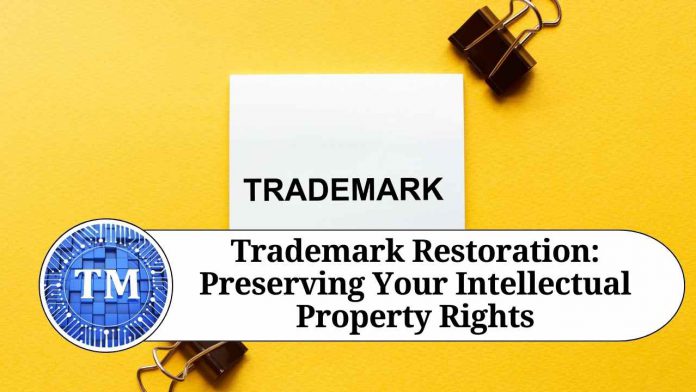Introduction
In today’s competitive business landscape, trademarks play a crucial role in protecting a company’s brand identity and distinguishing its products or services from competitors. However, maintaining a trademark requires consistent effort and periodic renewal. Failure to renew a trademark can result in its cancellation or abandonment. But fear not, as trademark restoration offers a lifeline to those who have inadvertently allowed their trademark to lapse. In this blog post, we will explore the concept of trademark restoration and discuss the steps involved in reclaiming your intellectual property rights.
Understanding Trademark Restoration: Trademark restoration is a legal process that allows the owner of a lapsed or abandoned trademark to reinstate their rights and regain exclusive use of the mark. It provides a second chance to rectify an unintentional oversight and recover the valuable asset that is a trademark. However, it is important to note that restoration is not always guaranteed, and specific conditions and timeframes must be met.
Eligibility for Trademark Restoration: To be eligible for trademark restoration, certain criteria must be fulfilled:
- Timeliness: The restoration application must be filed within a specified timeframe after the mark’s abandonment. This time window varies depending on the jurisdiction, so it is crucial to act promptly upon realizing the trademark’s lapse.
- Good Faith: The trademark owner must demonstrate that the abandonment was unintentional and the result of an honest mistake. This typically involves proving that steps are being taken to resume use of the mark and that there was no intention to abandon the trademark rights.
- Non-Deceptive Intent: It is essential to establish that the owner did not intentionally deceive the public by creating a new mark or abandoning the old mark while continuing to use a similar one.
The Restoration Process: Trademark restoration involves several steps and typically requires interaction with the relevant intellectual property office. While the exact process may vary depending on the jurisdiction, the following general steps outline the restoration process:
- Research: Verify the eligibility criteria and requirements for restoration set by the specific intellectual property office where the mark was registered. Understand the applicable timeframe and gather all necessary documentation.
- Filing the Application: Prepare and submit a restoration application to the relevant authority. This typically includes a detailed explanation of the unintentional abandonment, evidence of ongoing efforts to resume trademark use, and any additional documentation requested by the office.
- Examination and Review: The intellectual property office will review the restoration application, considering the evidence provided and ensuring compliance with all requirements. They may request further information or clarification during this stage.
- Decision and Notification: Based on the merits of the case and adherence to the restoration criteria, the intellectual property office will make a decision regarding the restoration. If approved, the trademark owner will be notified, and the mark will be reinstated.
- Post-Restoration Actions: After the restoration, it is crucial to resume active use of the trademark to maintain its validity. Engage in the normal trademark maintenance practices, such as monitoring and protecting against potential infringements.
Conclusion
Trademark restoration serves as a vital recourse for those who unintentionally allow their trademarks to lapse. By following the proper procedures and demonstrating good faith, trademark owners can potentially reclaim their intellectual property rights and safeguard their brand identity. However, prevention is always better than cure when it comes to trademarks. Maintaining a proactive approach, diligently monitoring renewal deadlines, and seeking legal counsel when necessary will help prevent lapses and ensure the long-term protection of your valuable trademarks. Remember, trademarks are valuable assets that contribute to your business’s reputation and success, so it’s essential to treat them with care and attention they deserve.
Other Related Blogs: Section 144B Income Tax Act
Frequently Asked Questions (FAQs)
Q. What is trademark restoration?
Trademark restoration is a legal process that allows the owner of a lapsed or abandoned trademark to reinstate their rights and regain exclusive use of the mark. It provides an opportunity to rectify unintentional oversights and recover the trademark’s protection.
Q. When is trademark restoration necessary?
Trademark restoration becomes necessary when a trademark owner unintentionally allows their trademark to lapse or become abandoned due to failure to renew it within the specified timeframe.
Q. What are the eligibility criteria for trademark restoration?
To be eligible for trademark restoration, certain criteria must be met. These typically include filing the restoration application within a specified timeframe, demonstrating good faith and non-deceptive intent, and providing evidence of ongoing efforts to resume use of the mark.
Q. How do I begin the trademark restoration process?
To start the trademark restoration process, you should research the requirements and timeframe set by the relevant intellectual property office. Gather all necessary documentation, including an explanation of the unintentional abandonment and evidence of efforts to resume trademark use. Then, file a restoration application with the appropriate authority.
Q. What documentation is typically required for trademark restoration?
The specific documentation required may vary depending on the jurisdiction. However, common documents include a detailed explanation of the abandonment, evidence of ongoing efforts to use the mark, any relevant communication or correspondence related to the abandonment, and any additional documentation requested by the intellectual property office.
Q. How long does the trademark restoration process take?
The duration of the trademark restoration process can vary depending on several factors, such as the workload of the intellectual property office and the complexity of the case. It is advisable to consult with a legal professional or the relevant authority for an estimate of the timeline.
Q. Is trademark restoration guaranteed?
Trademark restoration is not guaranteed. The intellectual property office carefully examines each restoration application, considering the evidence provided and ensuring compliance with the requirements. The decision to restore a trademark ultimately rests with the office based on the merits of the case.
Q. What happens if my trademark restoration application is approved?
If your trademark restoration application is approved, you will receive a notification from the intellectual property office, and your trademark rights will be reinstated. You can resume using the mark and take the necessary steps to protect and maintain its validity.
Q. Can I use my trademark during the restoration process?
While the trademark restoration process is underway, it is advisable to refrain from using the mark until you receive confirmation of the restoration. Once the restoration is approved, you can resume using the mark as before.
Q. What can I do to prevent the need for trademark restoration?
To avoid the need for trademark restoration, it is important to maintain a proactive approach to trademark management. This includes diligently monitoring renewal deadlines, keeping accurate records, seeking legal counsel when necessary, and engaging in ongoing trademark maintenance practices.




















